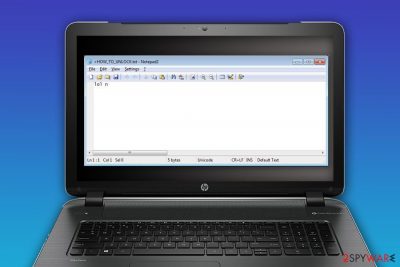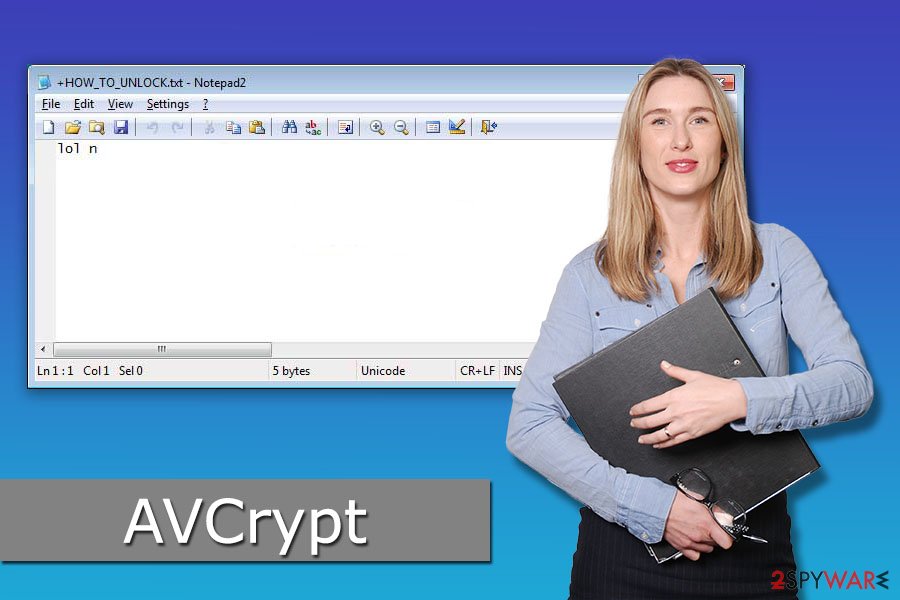AVCrypt ransomware (Decryption Steps Included) - Removal Guide
AVCrypt virus Removal Guide
What is AVCrypt ransomware?
AVCrypt – ransomware that tries to uninstall security program on the affected Windows PC

AVCrypt is a malicious program that is designed to uninstall antivirus and security software on the targeted computer. Currently, it’s unknown if the virus is in-development ransomware or a wiper. However, the virus drops an empty +HOW_TO_UNLOCK.txt file which is supposed to be ransom note.
| Summary | |
| Name | AVCrypt |
| Type | Ransomware |
| Danger level | High. Makes system changes, deletes files and antivirus software |
| Symptoms | Encrypted files, deleted antivirus |
| Distribution methods | Malicious spam emails, bogus software downloads and updates, exploit kits, etc. |
| To uninstall AVCrypt install FortectIntego and run a full system scan. | |
However, the significant feature of the AVCrypt virus is the ability to remove security programs soon after the infiltration. The malicious program specifically targets Windows Defender and Malwarebytes and deletes Windows services in order to stop their proper operation.
Furthermore, AVCrypt queries to check what antivirus program is registered with Windows Security Center.[1] Then it uses WMIC[2] in order to delete it. However, the recent analysis tells that malware is not able to eliminate all security programs, meaning that some tool can be immune and used for virus elimination.
AVCrypt malware has features of both ransomware and a wiper. Therefore, it has features of both. It might delete specific Windows service to cause problems with proper work of the operating system. However, apart from that, this cyber threat is designed to encrypt files and drops a ransom note soon after that.
AVCrypt ransomware does not start encryption immediately after infiltration. It remains still for a while and then connects to Command and Control server via TOR. The server responds with:
- encryption key;
- timezone;
- a version of the targeted Windows system.
However, during this procedure, some errors occur, and this allows assuming that malware is still under construction. Before running system scan for data encryption, malware deletes antivirus programs. During the encryption, malware renames files using this path:
+[original_name]
Following the encryption AVCrypt ransomware creates a previously mentioned +HOW_TO_UNLOCK.txt file in each folder that contains the encrypted files. Undoubtedly, this file is supposed to be ransom note. However, it includes “lol n” message, and nothing else: no data recovery instructions, no Bitcoin demands, no contact email address. Though, it is expected that malware is still in-dev mode and might be updated to full ransomware anytime soon.
Currently, Microsoft detects this cyber threat as Ransom:Win32/Pactelung.A, so it can be deleted with a professional security software. We highly recommend urging AVCrypt removal because it already has destructive features and makes the system vulnerable. Though, it can be updated any minute.
The virus modifies and adds new Windows Registry values, deletes its files, event logs, ransomware processes and wipes out autorun entry. To clean the computer and fix the damage, we recommend you to remove AVCrypt with FortectIntego.

Possible ways to get infected with malware
The specific methods how this destructive malware spreads are unknown. Cybercriminals might be using one of the following popular strategies:
- malicious spam email attachments;
- malvertising;
- bogus software updates or downloads;
- exploit kits.
Therefore, paying attention to general security tips is needed to avoid cyber attacks. Additionally, specialists from NoVirus.uk[3] remind to install a reputable antivirus program and keep it update as well as other programs and operating system. Additionally, we urge to make data backups and update them regularly as well. After ransomware attack, they save you from the loss of important information.
Uninstall AVCrypt ransomware virus
For AVCrypt removal, you have to use professional security software. Indeed, the virus can delete a security software that is installed on your PC. Though, you may need to install a new tool. However, you should reboot the computer to Safe Mode with Networking first to disable the virus as shown below.
If you are not sure what program to choose for elimination, you can use FortectIntego, SpyHunter 5Combo Cleaner or Malwarebytes. We can ensure that these tools can remove AVCrypt entirely. Moreover, if you do not have data backups and need file recovery solutions, try the methods suggested below.
Getting rid of AVCrypt virus. Follow these steps
Manual removal using Safe Mode
This method helps to disable the virus and run its automatic elimination.
Important! →
Manual removal guide might be too complicated for regular computer users. It requires advanced IT knowledge to be performed correctly (if vital system files are removed or damaged, it might result in full Windows compromise), and it also might take hours to complete. Therefore, we highly advise using the automatic method provided above instead.
Step 1. Access Safe Mode with Networking
Manual malware removal should be best performed in the Safe Mode environment.
Windows 7 / Vista / XP
- Click Start > Shutdown > Restart > OK.
- When your computer becomes active, start pressing F8 button (if that does not work, try F2, F12, Del, etc. – it all depends on your motherboard model) multiple times until you see the Advanced Boot Options window.
- Select Safe Mode with Networking from the list.

Windows 10 / Windows 8
- Right-click on Start button and select Settings.

- Scroll down to pick Update & Security.

- On the left side of the window, pick Recovery.
- Now scroll down to find Advanced Startup section.
- Click Restart now.

- Select Troubleshoot.

- Go to Advanced options.

- Select Startup Settings.

- Press Restart.
- Now press 5 or click 5) Enable Safe Mode with Networking.

Step 2. Shut down suspicious processes
Windows Task Manager is a useful tool that shows all the processes running in the background. If malware is running a process, you need to shut it down:
- Press Ctrl + Shift + Esc on your keyboard to open Windows Task Manager.
- Click on More details.

- Scroll down to Background processes section, and look for anything suspicious.
- Right-click and select Open file location.

- Go back to the process, right-click and pick End Task.

- Delete the contents of the malicious folder.
Step 3. Check program Startup
- Press Ctrl + Shift + Esc on your keyboard to open Windows Task Manager.
- Go to Startup tab.
- Right-click on the suspicious program and pick Disable.

Step 4. Delete virus files
Malware-related files can be found in various places within your computer. Here are instructions that could help you find them:
- Type in Disk Cleanup in Windows search and press Enter.

- Select the drive you want to clean (C: is your main drive by default and is likely to be the one that has malicious files in).
- Scroll through the Files to delete list and select the following:
Temporary Internet Files
Downloads
Recycle Bin
Temporary files - Pick Clean up system files.

- You can also look for other malicious files hidden in the following folders (type these entries in Windows Search and press Enter):
%AppData%
%LocalAppData%
%ProgramData%
%WinDir%
After you are finished, reboot the PC in normal mode.
Remove AVCrypt using System Restore
-
Step 1: Reboot your computer to Safe Mode with Command Prompt
Windows 7 / Vista / XP- Click Start → Shutdown → Restart → OK.
- When your computer becomes active, start pressing F8 multiple times until you see the Advanced Boot Options window.
-
Select Command Prompt from the list

Windows 10 / Windows 8- Press the Power button at the Windows login screen. Now press and hold Shift, which is on your keyboard, and click Restart..
- Now select Troubleshoot → Advanced options → Startup Settings and finally press Restart.
-
Once your computer becomes active, select Enable Safe Mode with Command Prompt in Startup Settings window.

-
Step 2: Restore your system files and settings
-
Once the Command Prompt window shows up, enter cd restore and click Enter.

-
Now type rstrui.exe and press Enter again..

-
When a new window shows up, click Next and select your restore point that is prior the infiltration of AVCrypt. After doing that, click Next.


-
Now click Yes to start system restore.

-
Once the Command Prompt window shows up, enter cd restore and click Enter.
Bonus: Recover your data
Guide which is presented above is supposed to help you remove AVCrypt from your computer. To recover your encrypted files, we recommend using a detailed guide prepared by 2-spyware.com security experts.If your files are encrypted by AVCrypt, you can use several methods to restore them:
Data Recovery Pro can help to restore some files
Some of the encrypted files can be restores with Data Recovery Pro. Though, it’s not an official AVCrypt ransomware decryptor.
- Download Data Recovery Pro;
- Follow the steps of Data Recovery Setup and install the program on your computer;
- Launch it and scan your computer for files encrypted by AVCrypt ransomware;
- Restore them.
Try ShadowExplorer
AVCrypt deletes numerous Windows files and kills processes. However, if it fails to delete Shadow Volume Copies of the targeted files, you should be able to restore some of the data with ShadowExplorer.
- Download Shadow Explorer (http://shadowexplorer.com/);
- Follow a Shadow Explorer Setup Wizard and install this application on your computer;
- Launch the program and go through the drop down menu on the top left corner to select the disk of your encrypted data. Check what folders are there;
- Right-click on the folder you want to restore and select “Export”. You can also select where you want it to be stored.
AVCrypt decryptor is not available.
Finally, you should always think about the protection of crypto-ransomwares. In order to protect your computer from AVCrypt and other ransomwares, use a reputable anti-spyware, such as FortectIntego, SpyHunter 5Combo Cleaner or Malwarebytes
How to prevent from getting ransomware
Access your website securely from any location
When you work on the domain, site, blog, or different project that requires constant management, content creation, or coding, you may need to connect to the server and content management service more often. The best solution for creating a tighter network could be a dedicated/fixed IP address.
If you make your IP address static and set to your device, you can connect to the CMS from any location and do not create any additional issues for the server or network manager that needs to monitor connections and activities. VPN software providers like Private Internet Access can help you with such settings and offer the option to control the online reputation and manage projects easily from any part of the world.
Recover files after data-affecting malware attacks
While much of the data can be accidentally deleted due to various reasons, malware is one of the main culprits that can cause loss of pictures, documents, videos, and other important files. More serious malware infections lead to significant data loss when your documents, system files, and images get encrypted. In particular, ransomware is is a type of malware that focuses on such functions, so your files become useless without an ability to access them.
Even though there is little to no possibility to recover after file-locking threats, some applications have features for data recovery in the system. In some cases, Data Recovery Pro can also help to recover at least some portion of your data after data-locking virus infection or general cyber infection.
- ^ Windows Security Center. Developer Network. Microsoft official website.
- ^ Windows Management Instrumentation. Wikipedia. The free encyclopedia.
- ^ No Virus. No Virus. British cyber security news.





















